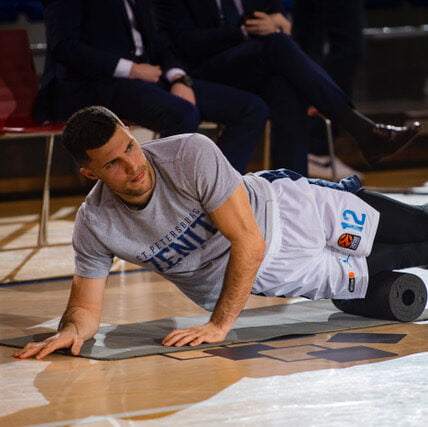In the last years professional sports teams are increasing the numbers of games, their intensity and willingness to be competitive, which calls for a detailed training process that must be prepared for this level of competition.
For EuroLeague teams that are aiming to reach the final stage of their competitions, and hopefully win a trophy, it is becoming quite common to play about 80-90 games per season. The schedule is hectic and most teams now have two EuroLeague games and one domestic league game per week, together with some long travels in between. For this reason, monitoring, and consequently planning a proper training schedule and playing load, has become fundamental for any team and for any player. This is the only way to be ready for such a challenging season.
As clearly explained from authors (Fig.1), having the possibility to quantify the External Load, it’s just the starting point of this process – one face of the medal, the most visible one. Nowadays, with modern technology like GPS or LPS systems, microtechnology and time motion analysis, it has become easier to cover the need of measuring a great number of details and variables. But how the athlete is responding to training stimulus depends on many other aspects, like personal characteristics, training , psychological , health status, quality of nutrition, environment, and last but not least – genetics and epigenetics, just to list the main ones.

F M Impellizzeri, S M Marcora, and A J Coutts, International Journal of Sports Physiology and Performance, 2019.
 Trying to quantify also how the athlete is personally responding to training/playing requests has become crucial, and for this important aspect there are many modalities that can be applied, all of them with some pros and cons. Usually, some physcho/physiological markers like the hearth rate, or some hematological, sweat or salivary markers can be monitored. However, these methods are not always easy to be applied when there are many players to follow, and these methods are undoubtedly difficult to be used daily for 9-10 months each season.
Trying to quantify also how the athlete is personally responding to training/playing requests has become crucial, and for this important aspect there are many modalities that can be applied, all of them with some pros and cons. Usually, some physcho/physiological markers like the hearth rate, or some hematological, sweat or salivary markers can be monitored. However, these methods are not always easy to be applied when there are many players to follow, and these methods are undoubtedly difficult to be used daily for 9-10 months each season.
A method that could be taken under consideration at any level, not just for its simplicity, but because it has shown also a strong scientific background, is the Session Rate of Perceived Exertion (sRPE). In basketball, this method has been widely used to assess training load (1), it has been shown to provide a good insight on the metabolic pathways related to energy production (2) and it has shown to be very consistent when coupled with external load data (3).
Using the Borg 10-point scale (Fig.2) (4) thirty minutes after the completion of each training session, players declare their perceived effort. Multiplying this value by the number of minutes of the session and calculating the sum of the values of each training session, it is possible to quantify approximatively how different players respond to the same training load. For example, if for a session of 90 minutes of training, a player’s RPE is 6, his session RPE is 540 AU (arbitrary units).

Fig. 2 Borg 10 points scale.
The simplicity of this RPE method hides some limitations, such as:
- It is subjective. For this reason, we cannot expect that from day one the players are able to be reliable and precise in their declarations of their effort. Additionally, athletes must be educated and experienced enough with the method to provide an accurate RPE.
- Effort is physical, but also cognitive and emotional (5). All these aspects are influencing each other, not only for what happens on the court. This variability must be taken under consideration, since athletes’ performance isn’t influenced only by their training.
- Numbers must be evaluated, but also interpretated. For many coaches, probably the main problem is not being able to standardize the method and understanding how numbers should be read. However, this could be seen as an opportunity to discover why players respond differently to training/playing load, which can lead to improved individualizing of players’ management and better recovery strategies.
 The training/playing load management has become a very hot topic, involving coaches, assistants and players, with the same common goal: trying to be as competitive as possible during a very demanding season. It has become “necessary” to have a strategy, using technology or not, and applying different procedures. Session RPE is one of them. It is applied easy, helps create player’s awareness, and provides indications to coaches which can optimize their work.
The training/playing load management has become a very hot topic, involving coaches, assistants and players, with the same common goal: trying to be as competitive as possible during a very demanding season. It has become “necessary” to have a strategy, using technology or not, and applying different procedures. Session RPE is one of them. It is applied easy, helps create player’s awareness, and provides indications to coaches which can optimize their work.
Authors: Francesco Cuzzolin, Mar Rovira, Igor Jukic, Julio Calleja-Gonzalez, Baris Kocaoglu, Jaime Sampaio, Sergej M. Ostojic
- Manzi V, D’Ottavio S, Impellizzeri F, Chaouachi A, Chamari K, Castagna C, et al. “Profile of Weekly Training Load in Elite Male Professional Basketball Players”, J Strength Cond Res. 2010; 24(5):1399–1406.
- Marinho A, de Barros Sousa F, de Alcântara Moura Pimentel Vilela R, Balikian Jr P, de Souza Bento E, et al. “The rating of perceived exertion is able to differentiate the post-matches metabolomic profile of elite U-20 soccer players”, European Journal of Applied Physiology (2021).
- Aoki MS, Torres Ronda L, Marcelino PR, Drago G, Carling C, Bradley PS, et al. Monitoring Training Loads in Professional Basketball Players Engaged in a Periodized Training Program, J Strength Cond Res. 2016:31(2):348–358.
- Borg, G. et al. (1983) A category-ratio perceived exertion scale: relationship to blood and muscle lactates and heart rate. Med. Sci. Sports Exerc., 15 (6), p. 523-528
- Marcora, S.M., Staiano, W. & Manning, V. (2009). Mental fatigue impairs physical performance in humans. Journal of Applied Physiology, 106, 857-864.




